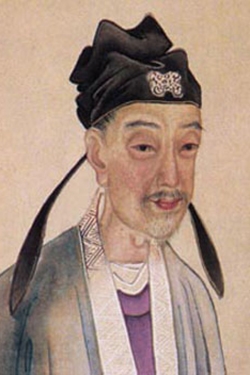Tang Dynasty Twitter
Those who follow the museum on Twitter, Facebook, etc. have probably noticed recent updates featuring lines translated from Tang Dynasty and other classical Chinese poetry. These are often inspired by other translations around the web, but I’ve had to develop shorter translations in order to fit the original Chinese characters (for the benefit of speakers and students of Chinese) in the same tweet. To a certain extent, this is certainly a bastardization of ancient classics, but all translations of literary Chinese into English tend to be either too cryptic to mean anything or so verbose they destroy the original prosody. Perhaps, in my amateurish and dictionary-dependent translations, the constraints of Twitter actually might be forcing a fruitful compromise between two unsatisfactory means of translation to produce one that conveys more (and more ambiguous) meanings in less words.
Chinese poetry is notoriously inaccessible to the roughly 80% of the world that cannot read or speak the language. And classical poetry from the Han 漢朝 or Tang dynasties 唐朝 uses enough obscure words and allusions to render it nearly incomprehensible to many Mandarin speakers as well. Not to mention the fact that pronunciation of Chinese characters has changed enough over the years to render ancient rhyme schemes moot, except to interested academics.
Yet China has a longer literary and artistic tradition than just about anywhere else, and its poetry conveys a uniquely austere, melancholy aesthetic with a deep reverence for the natural world. Each character conveys in a single syllable centuries of accumulated meaning and connotations, the ambiguity and richness of which cannot be fully translated. And this depth of meaning is conveyed in only a few spare words, producing an austere rhythm of carefully balanced verses. This aural simplicity is frequently cluttered and lost when one adds the meaningless mechanical articles and conjunctions necessary to stitch English phrases together.
 Thus, there are two fundamental styles of translating Chinese poetry: a literal translation of each word that preserves the spare cadence but is often too cryptic to be meaningful (like translating a web site with Google), or a more verbose translation of the meaning into English that either lacks any sort of rhythm or creates an arbitrary one (with an often simplistic rhyme scheme and inappropriate singsong tone). Numerous translations are available online, but the website http://www.chinese-poems.com/ does a good job of conveying the best of both worlds (thankfully, without imposing English rhymes) by presenting both approaches together. Here’s an example of an untitled poem by Li Shangyin 李商隱: (c. 813-858).
Thus, there are two fundamental styles of translating Chinese poetry: a literal translation of each word that preserves the spare cadence but is often too cryptic to be meaningful (like translating a web site with Google), or a more verbose translation of the meaning into English that either lacks any sort of rhythm or creates an arbitrary one (with an often simplistic rhyme scheme and inappropriate singsong tone). Numerous translations are available online, but the website http://www.chinese-poems.com/ does a good job of conveying the best of both worlds (thankfully, without imposing English rhymes) by presenting both approaches together. Here’s an example of an untitled poem by Li Shangyin 李商隱: (c. 813-858).| 來是空言去絕蹤, 月斜樓上五更鐘。 夢為遠別啼難喚, 書被催成墨未濃。 蠟照半籠金翡翠, 麝熏微度繡芙蓉。 劉郎已恨蓬山遠, 更隔蓬山一萬重。 | Come be empty word go without trace Moon slant tower on fifth watch bell Dream be far part call hard call Write reason hurry achieve ink not thick Candle shine half cover gold emerald Musk vapour tiny degree embroider lotus Liu young already regret Peng shan far More separate Peng shan ten thousand times | Her promises to come were empty words, she's gone without a trace, The moon is slanting on the tower as I hear the fifth watch bell. In my dream we were far apart, I found it hard to call, Hurriedly I try to write, but find the ink too thin. The candle's radiance covers half the gold and emerald bed, A tiny hint of musky scent remains on embroidered lotus. Young Liu already regretted that Pengshan hill lay far away, We two are separated by ten thousand Pengshan hills. |
Notice that in order to convey meaning in English, the translator essentially doubles the length of the text and inserts the narrator as an active protagonist. Of course, one eventually realizes the poet is longing for his love, but the stream of consciousness style and initial ambiguity of the first couple lines is lost in the second translation. In contrast, the first translation shows how the English language is not flexible enough to convey the full ambiguity of Chinese while still remaining meaningful. For example, the first two words “come be” sound like an invitation to the English reader, but they also could be translated as “What is to come/has come/is coming” or even “her promises to come,” which makes more sense when the next two characters are included in the translation: “Coming was empty speech/words/promise.”
However, Chinese speakers have told me multiple times that Chinese poetry is not about words’ meanings; it is more focused on conveying or creating a mood or feeling. In keeping with this idea, I would argue that ambiguity should be preserved as much as possible, especially in the initial verses. For example, the first line of this poem conveys a sense of emptiness and sudden departure without any physical referent. Thus, the verse appeared on Twitter as, “Coming from emptiness, words suddenly go.” In retrospect, “Coming was empty promise, gone without trace” might be more accurate given the context. In classical Chinese, there were no commas (or any other punctuation) to clarify.



Comments
Post a Comment